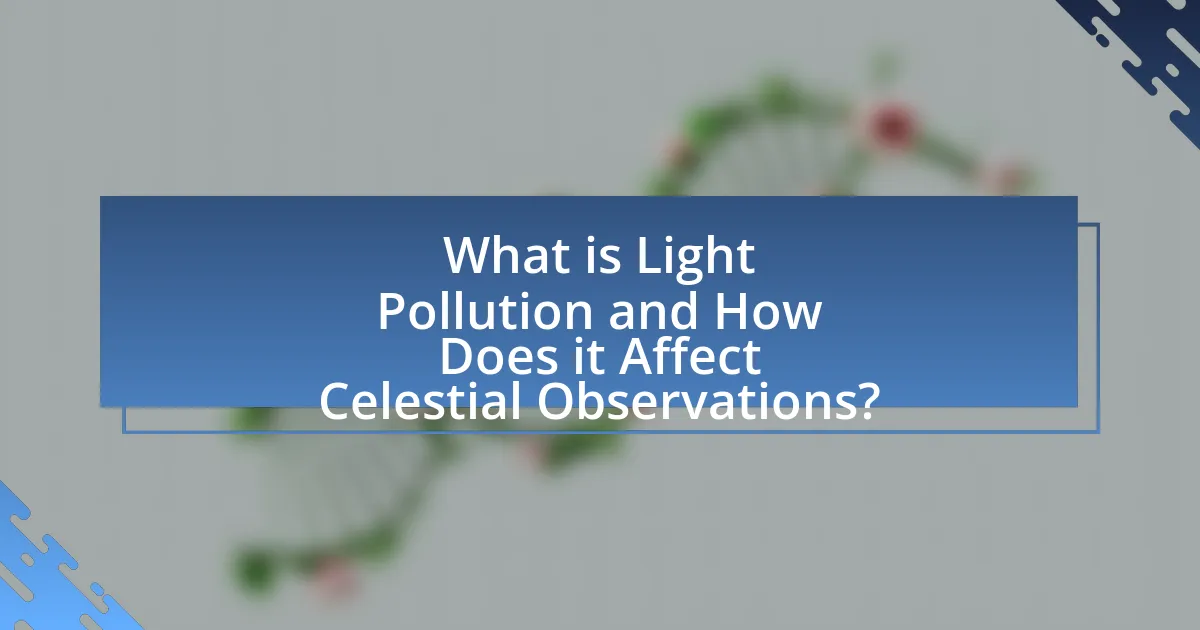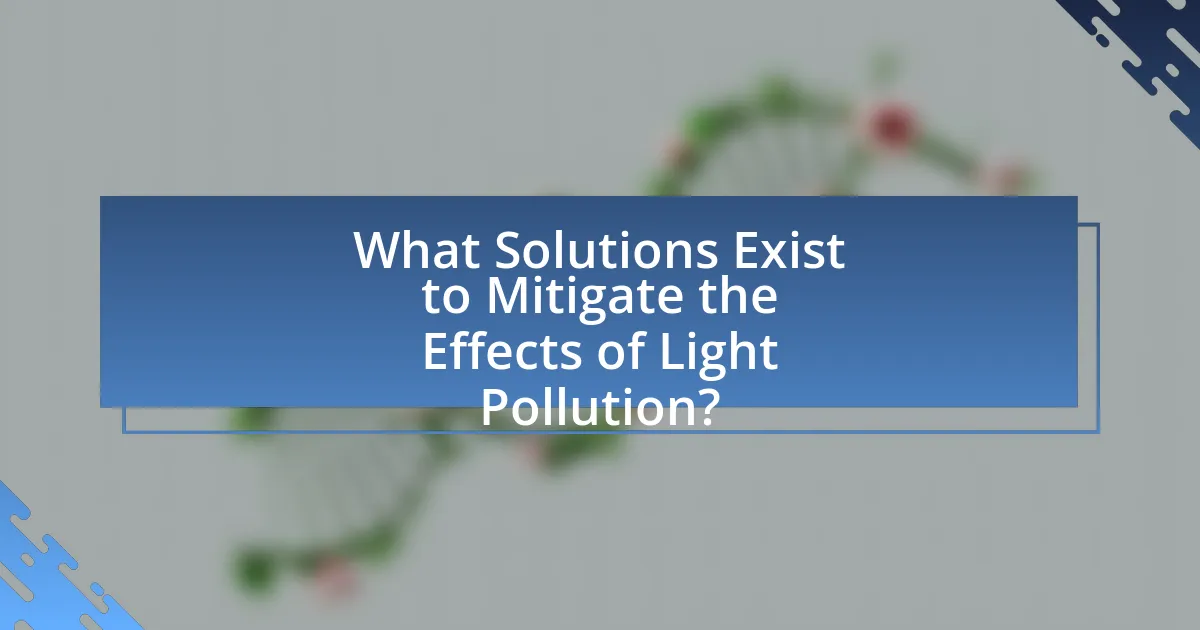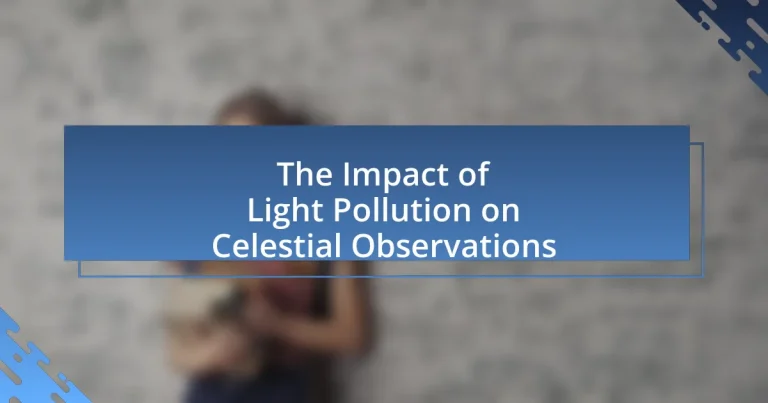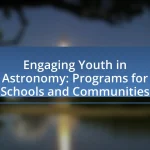Light pollution refers to the excessive or misdirected artificial light that brightens the night sky, significantly hindering the visibility of celestial objects such as stars and planets. Over 80% of the global population lives under light-polluted skies, which obscures astronomical observations and disrupts ecosystems and human circadian rhythms. The article explores various types of light pollution, including skyglow, glare, light trespass, and clutter, and discusses their detrimental effects on celestial observations. It also examines the role of urbanization in exacerbating light pollution, the long-term implications for astronomical research, and potential solutions to mitigate its impact, including community initiatives and technological advancements.

What is Light Pollution and How Does it Affect Celestial Observations?
Light pollution is the excessive or misdirected artificial light that brightens the night sky, hindering the visibility of celestial objects. This phenomenon affects celestial observations by obscuring stars, planets, and other astronomical features, making it difficult for both amateur and professional astronomers to conduct observations. Studies indicate that over 80% of the world’s population lives under light-polluted skies, significantly diminishing the ability to see the Milky Way and other celestial phenomena. The International Dark-Sky Association highlights that light pollution not only impacts astronomy but also disrupts ecosystems and human circadian rhythms, further emphasizing its broad implications.
What are the different types of light pollution?
The different types of light pollution include skyglow, glare, light trespass, and clutter. Skyglow refers to the brightening of the night sky over populated areas, caused by artificial light scattering in the atmosphere. Glare is excessive brightness that causes visual discomfort, often experienced when looking at bright lights. Light trespass occurs when unwanted artificial light spills over into areas where it is not needed, disrupting natural darkness. Clutter involves an excessive grouping of bright lights in an area, which can confuse the visual perception of the environment. Each type of light pollution negatively impacts celestial observations by obscuring stars and other astronomical phenomena, making it difficult for both amateur and professional astronomers to conduct observations.
How does skyglow impact our ability to see celestial bodies?
Skyglow significantly reduces our ability to see celestial bodies by increasing the brightness of the night sky, which obscures fainter stars and astronomical phenomena. This phenomenon occurs primarily due to artificial lighting from urban areas, which scatters in the atmosphere and creates a luminous background that diminishes contrast between celestial objects and the sky. Studies indicate that in heavily light-polluted areas, such as cities, the visibility of stars can decrease by up to 90%, making it challenging for both amateur and professional astronomers to observe and study celestial events.
What role does glare play in hindering astronomical observations?
Glare significantly hinders astronomical observations by overwhelming the faint light from celestial objects, making them difficult to detect. This phenomenon occurs when excessive artificial light scatters in the atmosphere, creating a bright background that obscures the visibility of stars and other astronomical features. Studies have shown that glare can reduce the contrast between celestial bodies and the sky, leading to a loss of detail and diminished observational quality. For instance, research indicates that urban areas with high levels of light pollution experience a drastic reduction in the number of visible stars, often down to a few dozen, compared to rural areas where thousands can be seen.
Why is light pollution a growing concern for astronomers?
Light pollution is a growing concern for astronomers because it significantly hampers their ability to observe celestial objects. The excessive artificial light from urban areas obscures the faint light emitted by stars and other astronomical phenomena, making it difficult to conduct precise observations. Studies indicate that nearly 80% of the world’s population lives under light-polluted skies, which limits the effectiveness of telescopes and reduces the quality of astronomical data collected. This interference not only affects professional astronomers but also impacts amateur stargazers and educational outreach efforts, as the visibility of celestial events is diminished.
How has urbanization contributed to increased light pollution?
Urbanization has significantly contributed to increased light pollution through the proliferation of artificial lighting in densely populated areas. As cities expand, the demand for streetlights, commercial signage, and residential lighting rises, leading to excessive illumination that obscures natural night skies. According to a study published in the journal “Science Advances,” urban areas can experience light levels up to 100 times brighter than rural regions, which disrupts ecosystems and hinders astronomical observations. This increase in artificial light not only affects visibility of celestial bodies but also alters wildlife behavior and human circadian rhythms.
What are the long-term effects of light pollution on astronomical research?
Light pollution significantly hinders astronomical research by obscuring celestial objects and reducing the visibility of faint astronomical phenomena. This interference leads to a decrease in the quality of data collected by telescopes, making it challenging for astronomers to conduct precise measurements and observations. For instance, studies indicate that light pollution can increase the sky brightness by a factor of 10 to 100 times in urban areas, severely limiting the ability to observe dim stars and galaxies. Consequently, this results in a loss of valuable scientific information, as many astronomical events and objects become undetectable. Furthermore, the long-term effects include a potential decline in public interest and funding for astronomical research, as the visibility of the night sky diminishes, reducing opportunities for education and outreach.

How Does Light Pollution Impact Specific Celestial Observations?
Light pollution significantly hinders specific celestial observations by obscuring faint astronomical objects. For instance, the visibility of stars, planets, and deep-sky objects like galaxies and nebulae is drastically reduced in urban areas due to excessive artificial light. Studies indicate that light pollution can diminish the visibility of stars by up to 90% in heavily populated regions, making it challenging for both amateur and professional astronomers to conduct observations. Additionally, light pollution interferes with the ability to detect transient astronomical events, such as meteor showers and supernovae, which require dark skies for optimal viewing.
What celestial phenomena are most affected by light pollution?
Light pollution most significantly affects celestial phenomena such as stars, planets, and the Milky Way galaxy. The brightness from artificial lights obscures the visibility of stars, making it difficult for observers to see fainter celestial objects. Studies indicate that over 80% of the world’s population lives under light-polluted skies, which severely limits the ability to observe the Milky Way, as its visibility diminishes in urban areas due to excessive artificial illumination. Additionally, light pollution disrupts astronomical research by hindering the detection of distant galaxies and other celestial bodies, as the background light interferes with the faint light emitted by these objects.
How does light pollution interfere with the observation of stars?
Light pollution significantly interferes with the observation of stars by obscuring their visibility against the brightened night sky. This phenomenon occurs when artificial light from urban areas scatters in the atmosphere, creating a haze that diminishes the contrast between celestial objects and the background sky. Studies indicate that over 80% of the world’s population lives under light-polluted skies, which limits the ability to see fainter stars and celestial phenomena. As a result, amateur and professional astronomers alike face challenges in conducting observations, as the brightness from artificial sources can outshine stars that would otherwise be visible in a darker environment.
What challenges does light pollution pose for observing planets and comets?
Light pollution significantly hinders the observation of planets and comets by obscuring faint celestial objects and reducing contrast against the night sky. This interference makes it difficult for astronomers and enthusiasts to detect and study these objects, as the brightness from artificial lights overwhelms the natural light emitted by planets and comets. Studies indicate that light pollution can decrease visibility of celestial phenomena by up to 90%, severely limiting the ability to observe details and movements. Consequently, effective astronomical observation requires dark skies, which are increasingly rare due to urbanization and artificial lighting.
How do different locations experience varying levels of light pollution?
Different locations experience varying levels of light pollution primarily due to factors such as urbanization, population density, and geographic features. Urban areas, for instance, typically exhibit higher light pollution levels due to concentrated artificial lighting from buildings, streetlights, and vehicles, which can create a skyglow effect that obscures celestial observations. According to a study published in the journal “Science Advances,” cities like Los Angeles and New York have significantly higher brightness levels compared to rural areas, where natural darkness prevails. Additionally, geographic features such as mountains or bodies of water can influence light pollution by either reflecting or diffusing artificial light, further contributing to the variability in light pollution across different locations.
What are the best practices for identifying light pollution levels in an area?
The best practices for identifying light pollution levels in an area include using light pollution measurement tools, conducting sky quality meter readings, and analyzing satellite data. Light pollution measurement tools, such as photometers, quantify the intensity of artificial light in specific wavelengths, providing accurate data on light pollution levels. Sky quality meters, which measure the brightness of the night sky, can be deployed at various locations to gather comparative data over time. Additionally, satellite data from sources like NASA’s Suomi NPP can offer comprehensive insights into light pollution patterns across larger regions, allowing for a broader analysis of its impact. These methods collectively enable researchers and communities to assess light pollution effectively and implement strategies for mitigation.

What Solutions Exist to Mitigate the Effects of Light Pollution?
Solutions to mitigate the effects of light pollution include implementing outdoor lighting regulations, using shielded fixtures, and promoting the use of lower-intensity lighting. Outdoor lighting regulations can limit excessive brightness and direct light towards the ground, reducing skyglow. Shielded fixtures prevent light from spilling into the night sky, thereby preserving visibility of celestial objects. Additionally, using lower-intensity lighting, such as LED bulbs with warmer color temperatures, minimizes the impact on nocturnal wildlife and human circadian rhythms. Studies indicate that these measures can significantly improve the quality of night skies, enhancing astronomical observations and reducing energy consumption.
How can communities reduce light pollution effectively?
Communities can effectively reduce light pollution by implementing outdoor lighting regulations that promote the use of shielded fixtures and lower-intensity lighting. These regulations can limit excessive brightness and direct light upwards, which contributes to skyglow. For instance, cities like Flagstaff, Arizona, have adopted strict lighting ordinances that require outdoor lights to be fully shielded, resulting in a significant reduction in light pollution and improved visibility of celestial bodies. Additionally, promoting public awareness campaigns about the importance of dark skies can encourage residents to adopt practices such as turning off unnecessary lights and using timers or motion sensors. Studies indicate that reducing light pollution not only enhances astronomical observations but also benefits local wildlife and human health by minimizing disruptions to natural circadian rhythms.
What role do local governments play in regulating outdoor lighting?
Local governments play a crucial role in regulating outdoor lighting to mitigate light pollution and protect celestial observations. They establish ordinances and zoning laws that dictate the types, intensities, and placements of outdoor lighting fixtures. For instance, many municipalities have adopted “dark sky” initiatives aimed at reducing excessive artificial light, which can interfere with astronomical research and the visibility of stars. These regulations often include requirements for shielding lights, using lower-intensity bulbs, and implementing curfews for outdoor lighting usage. Such measures are supported by studies indicating that light pollution adversely affects both wildlife and human health, as well as the ability to observe celestial bodies clearly.
How can individuals contribute to reducing light pollution in their neighborhoods?
Individuals can contribute to reducing light pollution in their neighborhoods by implementing measures such as using outdoor lighting fixtures that are fully shielded, which directs light downward and minimizes skyglow. Research indicates that unshielded lights contribute significantly to light pollution, with estimates suggesting that up to 30% of outdoor lighting is wasted due to improper fixture design. Additionally, individuals can advocate for community awareness about light pollution and support local regulations that promote responsible lighting practices. By participating in initiatives like “Dark Sky” programs, residents can help create environments that preserve natural nightscapes, which are essential for astronomical observations and wildlife.
What technologies are available to help combat light pollution?
Technologies available to help combat light pollution include smart lighting systems, shielding techniques, and adaptive lighting controls. Smart lighting systems utilize sensors and timers to adjust brightness based on the time of day and occupancy, reducing unnecessary illumination. Shielding techniques involve the use of fixtures that direct light downward, minimizing skyglow and glare. Adaptive lighting controls can automatically dim or turn off lights during specific hours, further decreasing light pollution. These technologies have been shown to significantly reduce the impact of artificial light on nocturnal ecosystems and improve visibility for astronomical observations.
How do shielding and smart lighting systems work to minimize light pollution?
Shielding and smart lighting systems minimize light pollution by directing light where it is needed and reducing unnecessary illumination. Shielding involves using fixtures that prevent light from spilling into the night sky, thereby limiting skyglow and preserving the visibility of celestial bodies. For example, full cutoff fixtures are designed to emit light only downward, which significantly decreases upward light pollution. Smart lighting systems utilize sensors and controls to adjust brightness based on real-time conditions, such as reducing light levels during low-traffic hours or turning off lights when not needed. Studies indicate that implementing these technologies can lead to a reduction in light pollution by up to 50%, enhancing both nocturnal wildlife habitats and astronomical observations.
What practical steps can amateur astronomers take to improve their observations?
Amateur astronomers can improve their observations by reducing light pollution exposure. They can achieve this by selecting darker observing locations away from city lights, using light shields or filters to minimize glare, and scheduling observations during new moon phases when the sky is darkest. Studies indicate that observing from locations with a Bortle Scale rating of 4 or lower significantly enhances visibility of celestial objects, as light pollution diminishes contrast and detail. Additionally, utilizing red LED lights for equipment and star charts preserves night vision, further enhancing the quality of observations.


